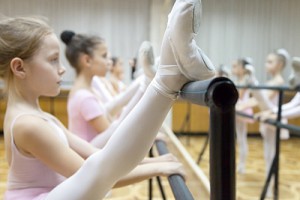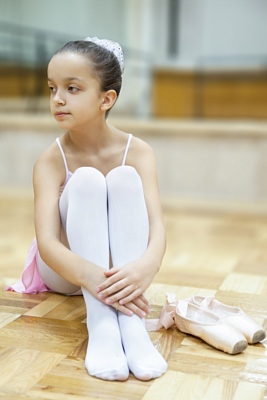Ballet exams and ballet exam grades put fear into both parents and children, and some of them don’t enter because they feel too scared, thinking that they need to be perfect to pass.
Well, there is nothing to worry about. Just like at school, ballet exam grades are a culmination of what you have achieved and learned over the past year. Without looming ballet exams, what goal would you have to work for? Why would you need to push yourself in class? To be honest, without a goal, would you really work to your fullest potential?
Knowing that you have ballet exam grades to work for makes you work harder in class and in turn you better yourself. This is a very important lesson for later in life. You always need to have something to work for if you want to achieve your goals. So many people forget this concept once they move off into the working world.
Everybody needs to have a goal that they are working towards, otherwise we never better ourselves.
How Do Ballet Exams and Ballet Exam Grades Work?
In most ballet societies it is more or less the same, but because I am an RAD Teacher (Royal Academy of Dance), I am going to talk about how the RAD Ballet Exams work. If you are taking ballet classes, you will only be able to do formal exams if your teacher is registered with a relevant organization.
For the very young little dancers, those under the age of five years, there is a preparation for ballet exams where they do a simple class in story format in front of the examiner with their teacher present. They earn themselves a certificate for their efforts. Nobody at this level can fail, and it serves to encourage the child, build up her confidence, and prepare her for future exams.
From the age of five years, they can go into Pre-Primary. This is an assessment exam, which is also done with their teacher present. This is to teach them the basics of ballet and let them master and know their work so that they can show it off to an outsider. For this assessment, the aim is enjoyment and to build confidence for future exams. They receive a certificate, a report, and a medal, which makes them feel very proud of themselves.
From the age of six, they can do Primary, which is the first formal exam. Normally the children at this age aren’t very nervous and have lots of fun working towards this first exam. The marking, although strict, is allocated in such a way that each child can shine in what they are good at. Some may be better at technique, some may have good musicality and others may be good at acting. A percentage is given out of 100 for this exam, marking all sorts of different criteria.
Thereafter they go from Grade 1 to Grade 8 in consecutive order. These exam levels are designed to progress the children at a rate that is safe for their bodies, and slowly develop the muscles that are needed for ballet, as well as strengthen their bodies.
The dancer who goes through the exam system will generally become a far better dancer than children who are just dancing for fun. They develop confidence and learn about good work ethic.
The more serious dancers, can venture out into major exams from Grade 5, and this is where the pressure starts, as children entered for major exams are looked at as future performers. This is where the children acquire their first pair of pointe shoes, and start to dance on the tips of their toes.
Ballet Exam Day!
 It’s the day of the ballet exams. The dressing rooms at the studio are full of nervous excitement for both teachers, students, and parents alike, and every year I wonder to myself ‘Why do I put myself and the kids through this?’ We seem to spend our entire year working for that unattainable perfection, that most of us never seem able to achieve, but it is the climb and the achievement knowing that you are now the best you will ever be that makes it all worthwhile.
It’s the day of the ballet exams. The dressing rooms at the studio are full of nervous excitement for both teachers, students, and parents alike, and every year I wonder to myself ‘Why do I put myself and the kids through this?’ We seem to spend our entire year working for that unattainable perfection, that most of us never seem able to achieve, but it is the climb and the achievement knowing that you are now the best you will ever be that makes it all worthwhile.
There is something that makes a dance exam special. Unlike schoolwork where you sit and write in privacy, with dancing you are displaying all your physical faults, weaknesses, and achievements to a total stranger, whom you will probably never see again. You are probably dancing better for that stranger than you have ever danced for your teacher because you know that this is either make or break time. You are giving a piece of your inner self, as you show all your emotions through your dancing. You will be performing and giving your best to the person sitting scrutinizing you and marking you. It is like dancing for your life, as you want to get the best result that you possibly can, and with dancing, we all know that that top result is extremely difficult to achieve, especially as you get to higher grades.
Even children or students who will never be professional dancers get a sense of achievement when performing an exam of exercises and dances that they couldn’t even do a couple of months ago. Learning new work is always difficult, but perfecting it and getting to finally perform it, gives one the ultimate sense of achievement.
Doing ballet exam grades equates well to life. You should always have goals that you are reaching for and working actively towards, and your life will be infinitely richer.


Hello Mergie,
I really like your website. This post is very informative and there is great information on Ballet Exams. People who are going to be looking for this kind of information will be happy to land on your site!
Ballet teaches you a lot about life, and one day if I have a girl I will definitely want her to join something like this.
All the best,
-Karissa
I agree Karissa. Ballet is often underlooked in favour of other sports, but ballet is one of the most disciplined and focused things for kids to do.